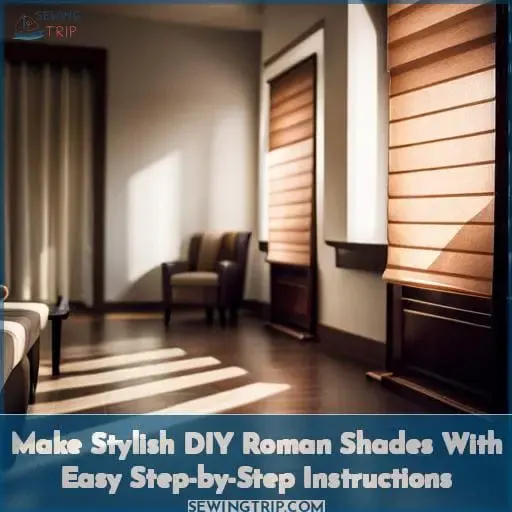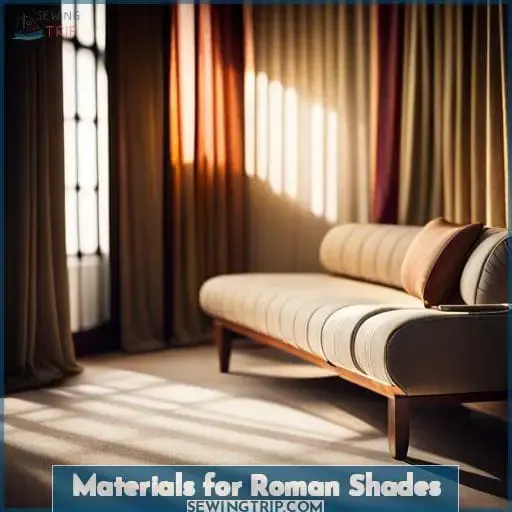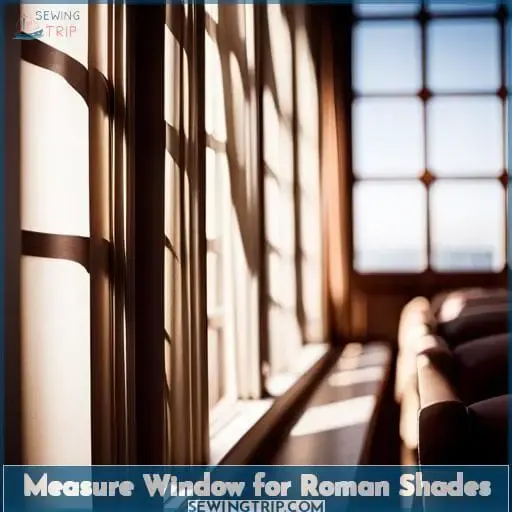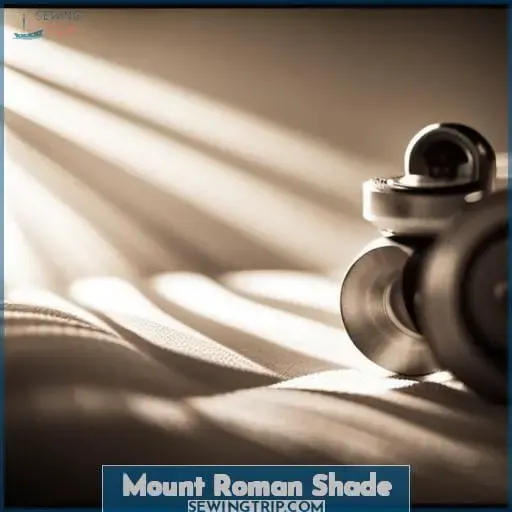This site is supported by our readers. We may earn a commission, at no cost to you, if you purchase through links.
 Let’s turn those cool yet expensive custom Roman shades into a DIY project!
Let’s turn those cool yet expensive custom Roman shades into a DIY project!
Measuring and sewing your own Roman shades is easier than you think. In a few steps, you’ll have stylish, custom window treatments without the price tag.
I’ll walk you through:
- Choosing fabrics
- Measuring your windows
- Sewing the side hems
- Creating dowel pockets
- Mounting your new Roman shades
With the right materials and easy instructions, you can create these elegant shades affordably.
Say goodbye to boring blinds and hello to chic DIY Roman shades!
Table Of Contents
Key Takeaways
Measure inside window dimensions and add extra length for headings and hems. Hem the sides and bottom using a double-fold technique for clean lines. Sew evenly spaced horizontal casings to insert dowels for support. Mount rings and cords correctly for proper functionality and child safety.
Materials for Roman Shades
You’ll want to pick out:
- A nice decorative fabric
- Wooden dowels to give the shades structure
- Mounting hardware to hang them up properly
- Basic sewing supplies like thread and needles
Having the right materials on hand will make completing your homemade Roman shades smooth sailing!
Fabric
Choose your decorative and lightweight fabric, which is the heart and soul of your Roman shades.
Opt for trendy designs and stylish patterns in coordinating colors that complement your home’s décor.
Consider coordinating fabrics for a cohesive look in multiple rooms.
Choose fabrics you love, whether that’s playful prints, luxurious textures, or eye-catching colors to make a dramatic style statement with your custom window treatments.
Wooden Dowels
Opt for 1/4-inch diameter wooden dowels to create the support structure within your custom Roman shades.
Cut dowels precisely to the window width for a tailored finish.
Space dowel casings 8 to 10 inches apart for sufficient support of decorative fabrics like linens or cottons.
For child safety, consider cordless options utilizing dowels and rings alone to draw the shades up and down.
Wooden dowels enable creativity in fabric choice for Roman shades while upholding function.
Mounting Hardware
You’ll also need some mounting hardware to hang your DIY Roman shades, like brackets, screws, eye screws, and thin nylon string.
Consider both functional and decorative options when selecting hardware.
Mount the shade high and wide for best light control and visibility.
Ensure cords are securely fastened and inaccessible to children for safety.
Alternative mounting methods like adhesive strips exist for rental spaces.
With the right materials and some creativity, you can install beautiful Roman shades to elevate any room.
Sewing Supplies
You’ll need a sewing machine, needle and thread, staple gun, and other basic sewing tools for assembling the roman shades:
- Sewing machine
- Needles
- Thread
- Staple gun
- Scissors
- Straight pins
- Seam ripper
- Fabric pencil or chalk
Having the right equipment on hand will make DIY roman shades an easy, enjoyable project resulting in stylish window treatments that lend a customized designer touch to any room.
Measure Window for Roman Shades
When making your own Roman shades, the first step is to measure your window carefully.
You’ll need to decide whether you want an inside mount that fits within the window frame or an outside mount that extends beyond it, then measure the exact width.
Also, measure the total length you need for the shade to go from the top to the bottom of the window or where you want it to stop.
Inside Vs Outside Mount
When figuring out where you’ll hang your Roman shades, think through if you’ll mount them inside or outside the window frame to determine the necessary measurements.
An inside mount fits within the window recess for a clean and streamlined look.
An outside mount extends beyond the window frame, allowing for more light control and privacy options.
Consider stylish fabric choices that coordinate with your room’s aesthetic while also ensuring child-safe options like cordless or looped cords are used.
Width
When measuring for the width of your Roman shades, account for whether you’ll be mounting them inside or outside the window frame.
For inside mounts, make the shade width equal to the window width.
For outside mounts, add 4 inches on each side to allow space for the shade to clear window trim.
Select customized dimensions for width and length in conjunction with mounting location.
Coordinate with fabric print scale and room decor.
For maximum control of light and privacy, position cleats favorably.
Harmonize colors.
Length
Once you’ve measured your window’s width, next you’ll want to measure the height from top to bottom to determine the total length you need to cut your shade fabric.
- Measure from where you want the shade to start on the wall/window frame to where you want it to end.
- Add 10-12 inches to allow for hems, headings, and mount clearance.
- For extra child-safety, keep cords and strings out of reach by mounting shades high.
When choosing lengths, consider not only the window dimensions but also your desired look, functionality, and safety.
Getting the measurements right is crucial for properly installing your custom roman shades.
Sew Side and Bottom Hems
With your measurements complete, it’s time to transform that raw fabric into a beautiful Roman shade.
Carefully hem the sides and bottom using a 1/2-inch double-fold technique, leaving the bottom open at both ends for dowel insertion later.
Choose lightweight, solid fabrics or subtle prints so hemming stitches blend right in.
For kid-friendly windows, coordinate fabrics with rooms using cheerful colors or whimsical patterns they’ll adore waking up to.
With straight horizontal hemlines defining clean architectural lines, your shade will frame the view beyond in a liberating way.
Create Dowel Pockets
Next, you’ll create the dowel pockets that hold the rods to raise and lower your shades.
Mark horizontal lines across your fabric at evenly spaced intervals, leaving room at the top and bottom.
Then simply sew straight seams along those marks to create handy little sleeves for inserting dowels.
Mark Spacing
You’ll mark evenly spaced horizontal lines to create the dowel pockets.
Carefully measure and mark lines every 8-12 inches.
Use a fabric marker that will wash out.
Double check spacing accuracy.
Keeping the lines evenly spaced is crucial for the roman shade to hang properly. Take your time with this step to achieve the stylish look you desire in a safe, customizable way.
Sew Horizontal Lines
For the dowel pockets, mark horizontal lines at evenly spaced intervals across the width of the fabric.
Opt for a lightweight, decorative fabric that complements your home’s aesthetic.
When selecting hues, consider how coordinating shades can connect spaces for a cohesive look.
Move the fabric under the machine foot and stitch the marked lines using a straight or zigzag stitch, leaving openings on both ends for dowel insertion.
If tiny fingers will be accessing windows, child-safe alternatives like no-sew, fabric-wrapped shades are recommended.
Insert Dowels and Attach Rings
Once the dowel pockets are sewn, it’s time to insert the dowels and attach the rings.
Carefully slide the dowels into the horizontal casings you’ve created, making sure they glide smoothly from end to end.
Space the dowels evenly so your shade hangs beautifully when finished.
Now for the fun part – selecting those lovely rings!
Opt for complementary colors or materials that coordinate with your fabrics.
Measure about 3 inches from the ends of each dowel casing and hand-stitch a ring at each mark through both the front and lining fabric.
These rings will later hold the cords that lift your shade.
Make sure to double-check dowel alignment and test ring spacing by gently pulling the bottom ring to raise the fabric.
Ensure the pleats fold evenly before moving on to mounting the cords and cleat on your window frame.
Mount Cleat and Cords
Next, install a cleat for securing the cords.
Cut the cord to the measured window length and tie one end to the bottom rings on the left side of the shade.
Attach the other cord ends to the cleat once the shade is mounted to neatly keep the cords out of the way.
Cut Cord Length
How long should you cut the cords before mounting the cleat and attaching them to the rings on your DIY roman shades?
- Measure from the bottom ring, up and over the mounting board, and down to the desired hanging length.
- Add 8-12 inches to allow for adjustments.
Consider custom sizing for a perfect fit.
Check cord safety guidelines to prevent hazards.
Attach Cords to Rings
After cutting the cords to length, tie one end to the lowest rings on whichever side of the blind you want the cords to hang.
Securely knotting each cord to its corresponding bottom ring, position the cords just so before pulling them taut and affixing to the mounted cleat.
With cords set and shade raised, liberating light floods the room as you stand empowered, having crafted window treatments with your own capable hands to master the décor.
Mount Roman Shade
Next, it’s time to attach your custom Roman shade to the window frame.
Secure it in place with screws.
Raise the shade and arrange the pleats by hand.
Tie off the cords.
Let the pleats set for about a week before adjusting further so the fabric takes proper form.
Attach to Window Frame
You attach the Roman shade to the window frame by inserting two wood screws through the bottom of the mounting board.
Stand back and admire how the shade beautifully frames the window.
Arrange the cascading pleats by hand, spacing them evenly.
Let them set in place for a week before making any adjustments.
Consider coordinating or contrasting fabrics and trims to inject your personal style.
The decorative touches allow your Roman shade to make a vibrant statement.
Arrange Pleats
To achieve a professional and polished look, carefully arrange the pleats of your DIY Roman shade once it has been mounted.
Raise the shade to the desired height and secure the cords.
Gently pull the fabric taut from side to side, arranging the pleats evenly by hand.
Allow the pleats to set in place undisturbed for at least one week before adjusting further.
Decorative Touches
When choosing fabrics for your custom Roman shades, don’t forget about decorative touches to make them really pop.
Consider:
- Pairing coordinating fabrics
- Using contrasting trims along the edges
- Adding texture with piping
Small embellishments like buttons, tassels, or contrast stitching can also inject personality into basic Roman shade designs.
Coordinating Fabrics
Pairing complementary fabrics lends a polished look to your custom Roman shades.
Play with colorful fabric combinations, harmoniously pairing prints or introducing contrast through solids.
Create an intentional, curated aesthetic by coordinating fabrics between rooms.
Thoughtfully incorporate fabrics with shared colors or motifs for a cohesive style across your home.
Contrasting Trims
When making your DIY Roman shades, you can add interest by pairing them with contrasting trims.
- Add a bold, contrasting trim tape along the bottom edge.
- Sew on decorative trim pieces in eye-catching colors.
- Finish side seams with thick cording in an unexpected shade.
Experiment with unique trim styles and color combos for customized Roman shades with artistic edge accents.
Frequently Asked Questions (FAQs)
How do I choose an appropriate fabric? What types of fabrics work best?
Choose light, easy-to-work-with fabrics like linens or cottons.
Decorative fabrics that aren’t blackout-intended work best to let light filter through the folds.
Go with colors and patterns you love to make them your own.
Complementing fabrics can give a cohesive look across rooms.
Should I line my roman shades? What are the benefits?
Yes, lining your Roman shades:
- Enhances light filtering
- Blocks unwanted views
- Gives them a neat, professional finish
What size dowels are recommended? What is the standard size?
A 1/4-inch dowel is the standard size recommended for Roman shades.
Using a thin dowel allows the shade to stack neatly and roll smoothly when raised or lowered.
Bulkier dowels may make operating the shade more difficult.
How do I determine the optimal placement for the rings? Is there a general rule of thumb?
Unleash your inner design diva and let those rings dance where they may.
There are no rules, only opportunities for creative flair.
Embrace the chaos, break free from conformity, and let your instincts guide you.
How much light will filter through with roman shades? Are they good for rooms that need light blocking?
Unlike blackout shades, roman shades allow some light filtering.
The amount depends on fabric opacity:
- Sheers let in the most light.
- Heavier linens or cottons filter sunlight but maintain privacy.
For maximum light control, add a backing.
Conclusion
Believe it or not, over 50% of homes still have basic blinds.
But armed with fabric, a needle, and thread, you now have the know-how to create Roman shades that transform any room.
Making these elegant yet budget-friendly window treatments is easier than it looks.
Simply follow the step-by-step instructions, sew neat hems, hang the wooden dowels, and mount.
Voilà – in no time, you’ll be styling sunny windows with cozy, customized Roman shades.














